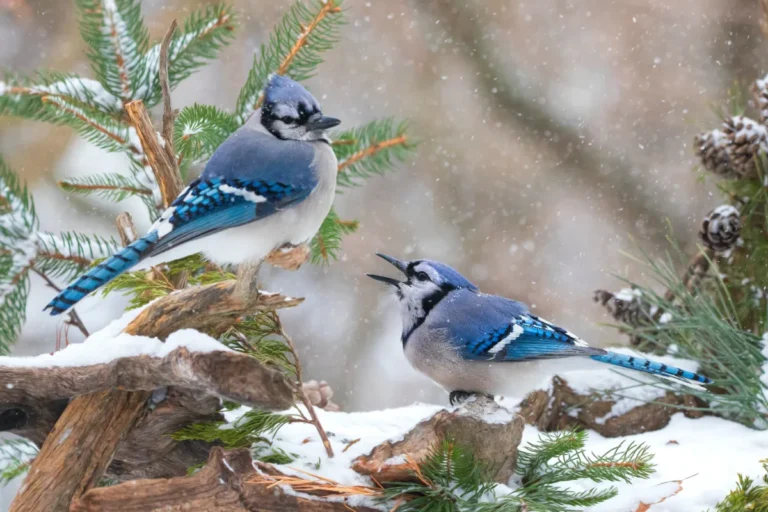15 Small Green Birds of Florida (With Pictures)
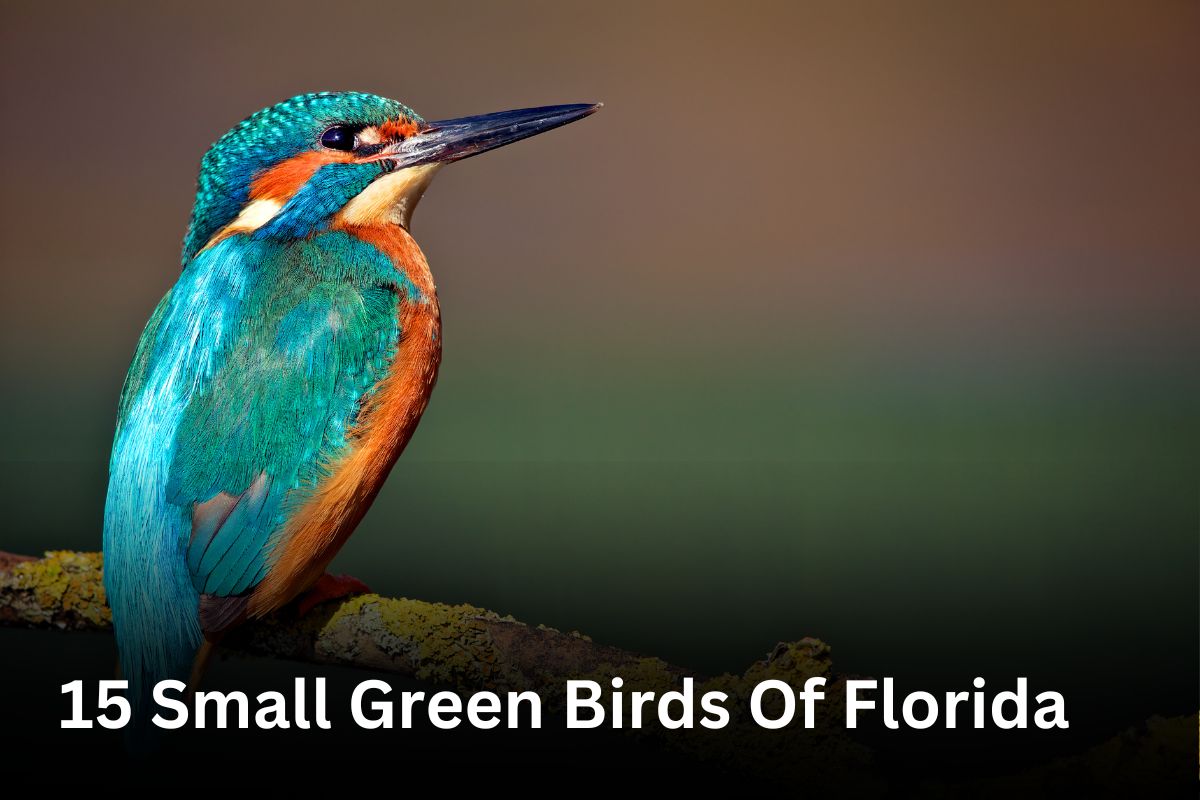
Identifying green-colored birds in Florida is more difficult than it appears, as there are numerous bird species that are either totally or partially green.
Florida is well-known for its animal and bird life, with over 500 bird species recorded by the Florida Ornithological Society Records Committee (FOSRC).
In this essay, we’ll go over the most common green birds in Florida to assist you in identifying the birds you observed.
15 Small Green Birds of Florida
- Green Heron
- Monk Parakeet
- Painted Bunting
- Northern Parula
- American Goldfinch
- Green Violetear
- Green Jay
- Green Parakeet
- Green Kingfisher
- Green-tailed Towhee
- Nanday Parakeet
- Pine Warbler
- Hooded Warbler
- Ruby-crowned Kinglet
- Ovenbird
Green Heron
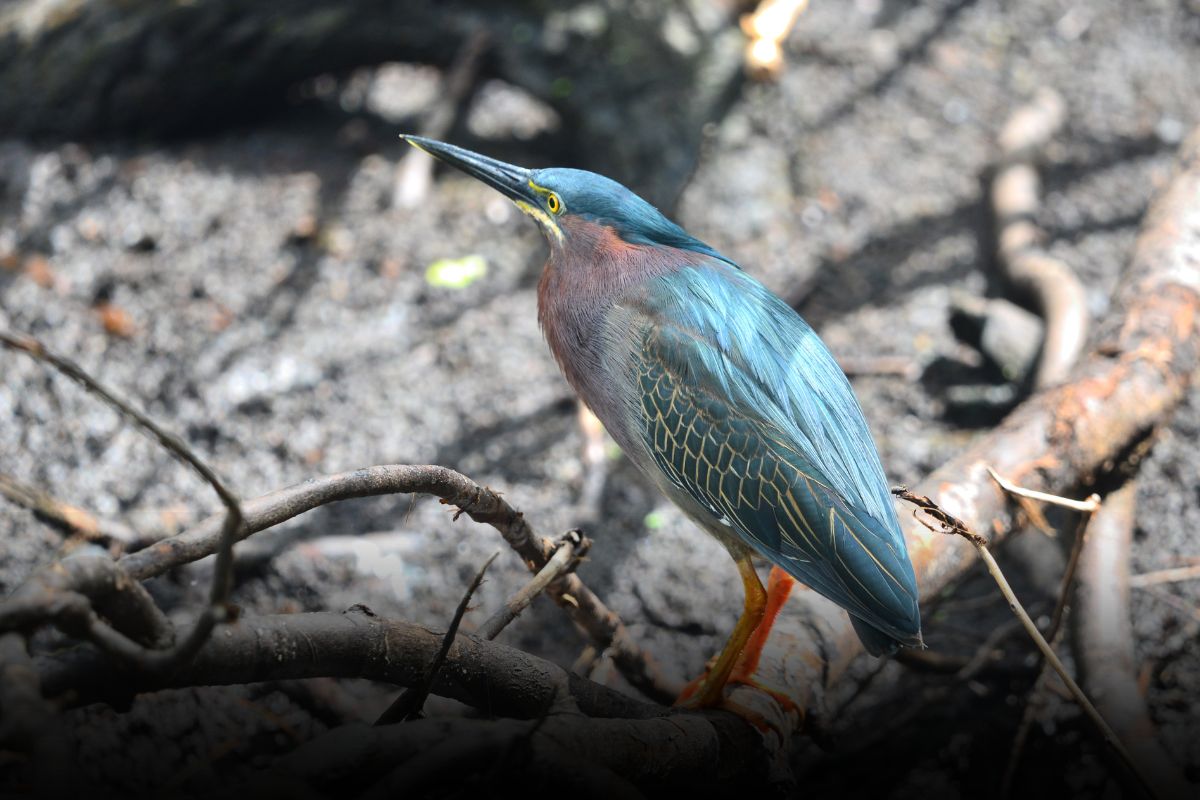
Where in Florida does it find?
The Green Heron can be found throughout Florida, including wetland areas such as marshes, swamps, and mangrove forests.
Short Description of the bird
The Green Heron is a small, stocky bird with a dark greenish-black back, chestnut-colored neck, and a small crest on its head. It has a short, sharp bill and short yellow legs.
Where to find this bird
Green Herons can be seen perched on branches or hidden among vegetation near the water’s edge. They are known for their stealthy hunting habits, patiently waiting for fish, frogs, and insects to come within reach.
Size of the bird, wings, weight
The Green Heron is about 16-18 inches long with a wingspan of 25-27 inches. It weighs between 8-11 ounces.
Diet
Green Herons primarily feed on small fish and amphibians, but they also eat insects, crustaceans, and small reptiles. They use their sharp bill to catch and devour their prey.
How to identify
The Green Heron can be recognized by its compact size, dark greenish-black back, chestnut-colored neck, and short, sharp bill. It has a distinctive habit of hunching down with its neck folded when it feels threatened.
Monk Parakeet
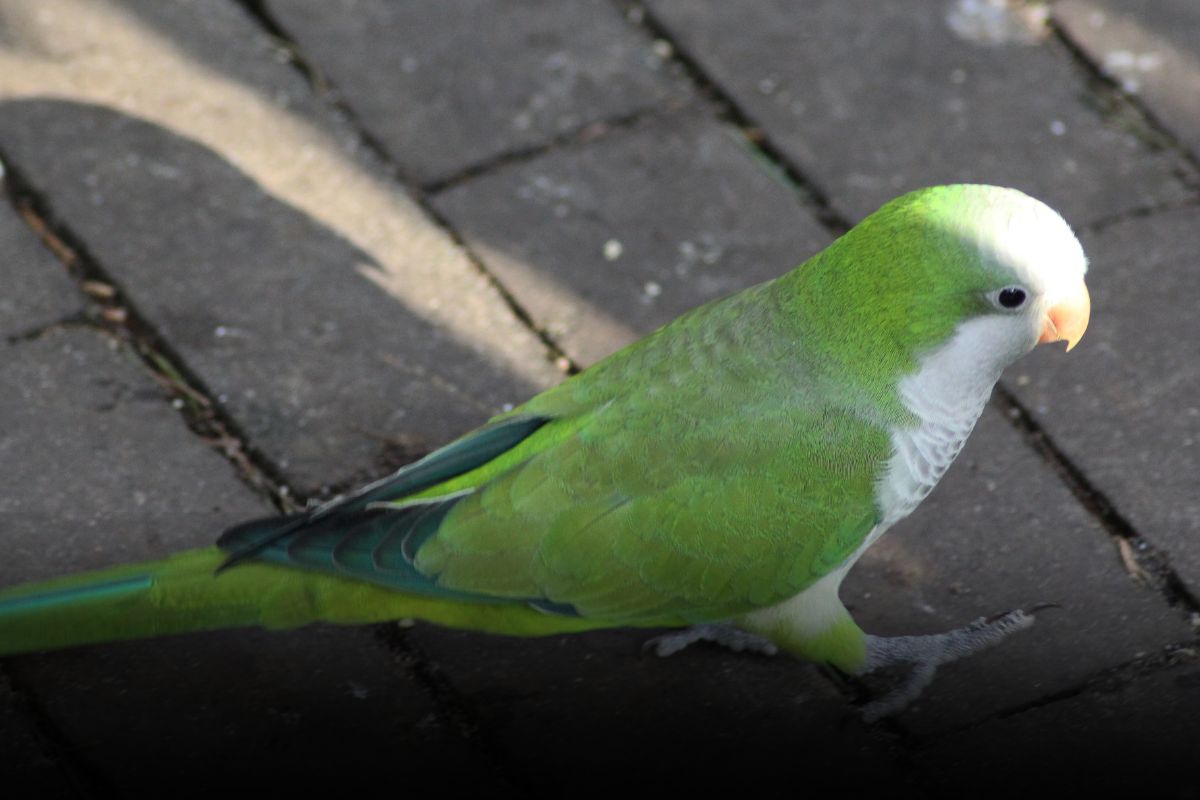
Where in Florida does it find?
Monk Parakeets can be found in various locations throughout Florida, including urban areas, parks, and open fields.
Short Description of the bird
Monk Parakeets are small, social birds with bright green plumage and a long, pointed tail. They have grey faces and a hooked bill.
Where to find this bird
Monk Parakeets often nest in large communal nests made of twigs, which can be found in trees or on man-made structures like telephone poles. They are highly adaptable and can be seen feeding on seeds, fruits, and nuts.
Size of the bird, wings, weight
Monk Parakeets are about 11-12 inches in length with a wingspan of 19-22 inches. They weigh around 3-4 ounces.
Diet
Monk Parakeets primarily feed on seeds, fruits, nuts, and berries. They have a strong beak that allows them to crack open nuts and seeds.
How to identify
Monk Parakeets are easily identifiable by their bright green plumage, gray face, long tails, and hooked bills. They are often seen in small flocks, making loud, squawking calls.
Painted Bunting
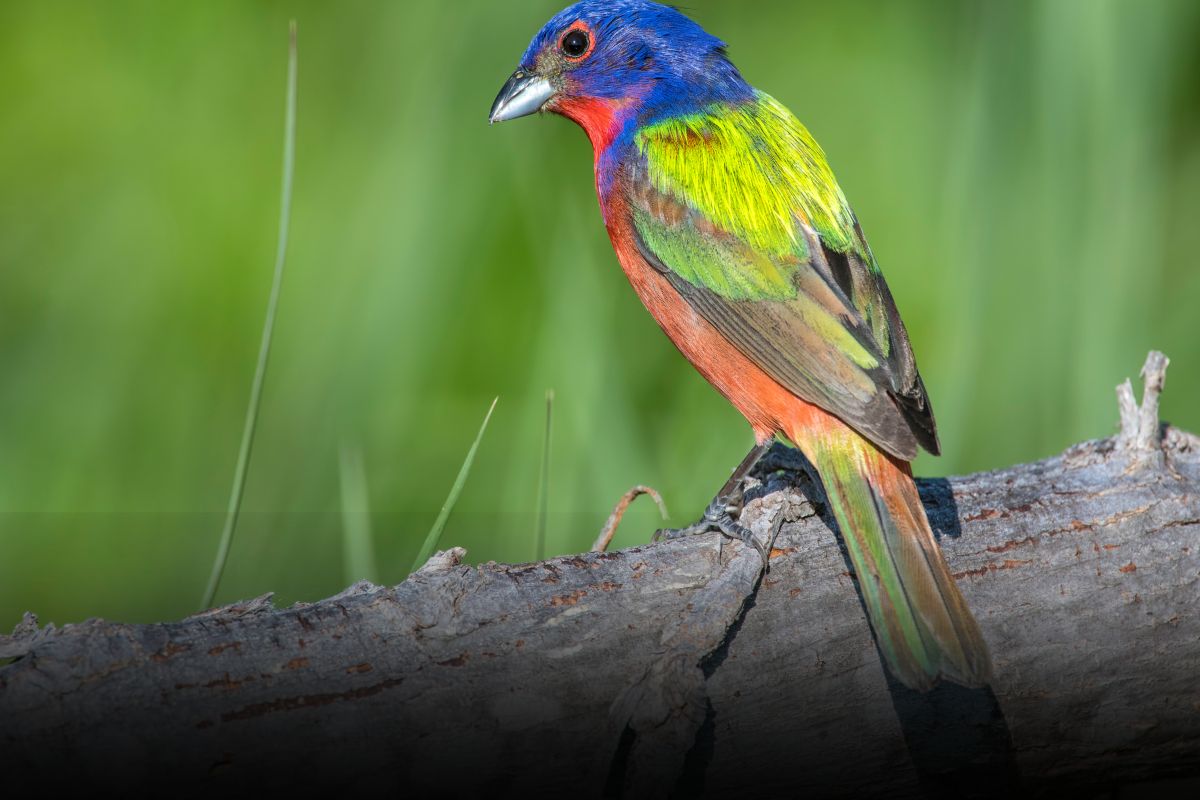
Where in Florida does it find?
The Painted Bunting can be found in the northern and central parts of Florida, particularly in shrubby habitats and areas with dense vegetation.
Short Description of the bird
The Painted Bunting is a small, colorful bird with a bright blue head, red breasts, and greenback. The female is more subdued, with greenish-yellow plumage.
Where to find this bird
Painted Buntings prefer dense thickets, shrubs, and brushy areas as their habitat. They have a habit of staying hidden among the foliage and are more often heard than seen.
Size of the bird, wings, weight
Painted Buntings are about 5-6 inches long with a wingspan of 7-9 inches. They weigh around 0.6-0.8 ounces.
Diet
Painted Buntings primarily feed on seeds, berries, and insects. They have a strong preference for seeds, especially those of grasses and weeds.
How to identify
The male Painted Bunting stands out with its vibrant blue head, red breast, and greenback. The female, on the other hand, has a greenish-yellow plumage with a touch of blue. Both have stout bills and are often seen perched on low branches or in thick vegetation.
Northern Parula
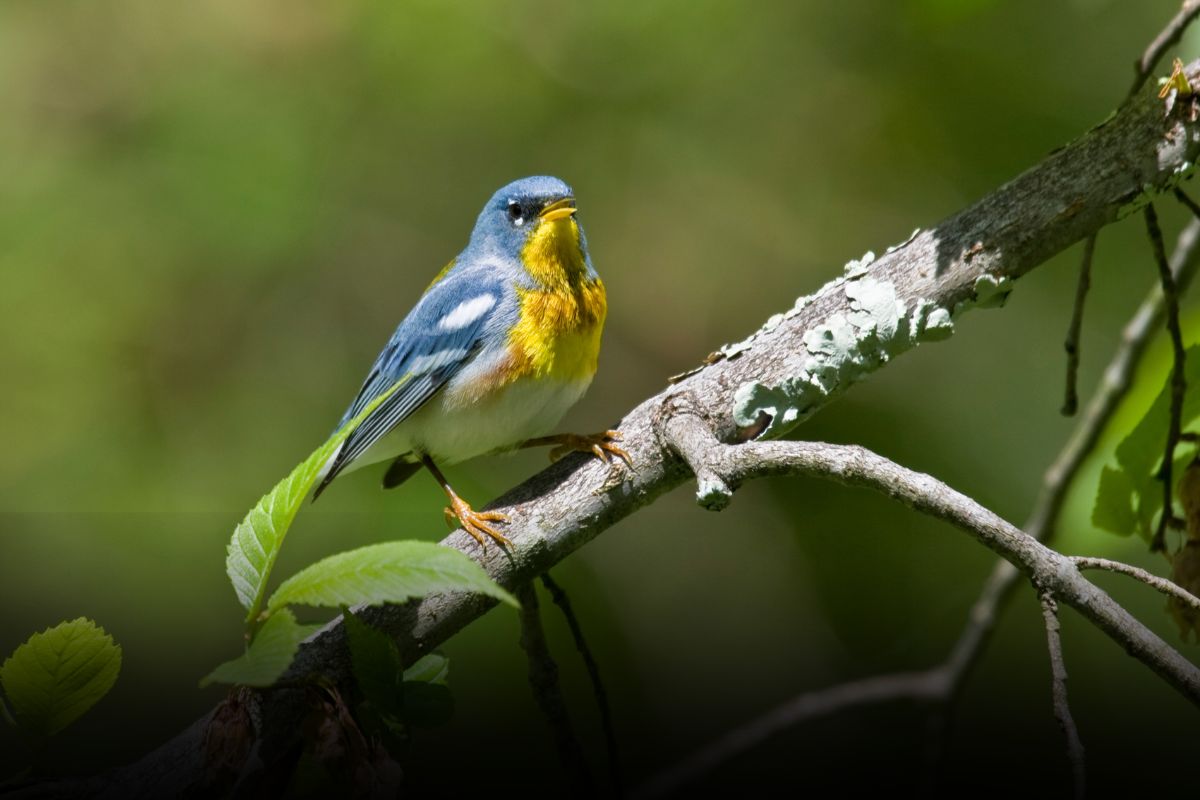
Where in Florida does it find?
The Northern Parula can be found in the northern and central parts of Florida, particularly in deciduous and mixed hardwood forests.
Short Description of the bird
The Northern Parula is a small, active bird with a bluish-gray back, greenish wings, and a yellow throat and breast. It has a distinctive white eye ring.
Where to find this bird
Northern Parulas prefer to inhabit dense tree canopies, especially near water sources. They are known for their fast and agile flight patterns as they catch insects on the wing.
Size of the bird, wings, weight
Northern Parulas are about 4-4.5 inches long with a wingspan of 6-7 inches. They weigh around 0.2-0.3 ounces.
Diet
Northern Parulas primarily feed on insects, including caterpillars, beetles, and spiders. They forage actively among the leaves, probing and gleaning insects from the foliage.
How to identify
The Northern Parula can be identified by its bluish-gray back, greenish wings, and yellow throat and breast. The white eye-ring is a distinctive feature. It can often be seen flitting and hovering around tree branches, showing off its vibrant plumage.
American Goldfinch
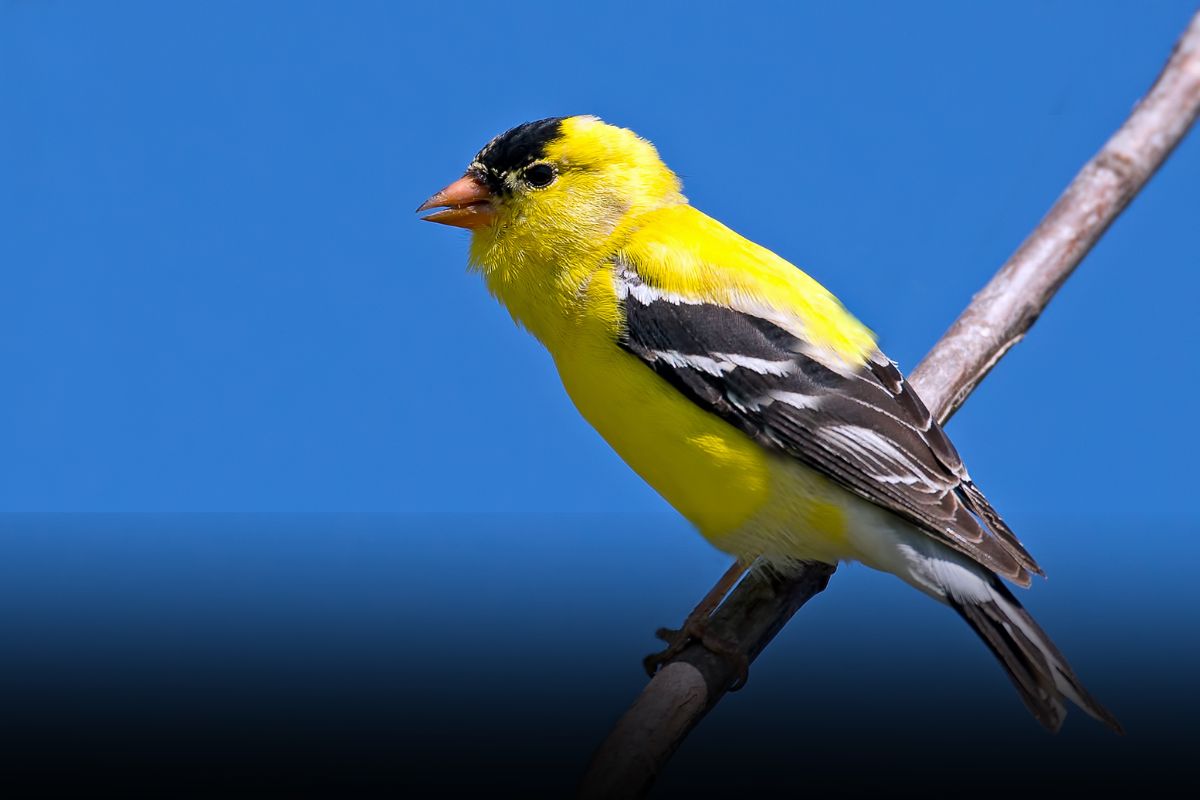
Where in Florida does it find?
The American Goldfinch can be found throughout Florida, particularly in open fields, meadows, and areas with abundant flowering plants.
Short Description of the bird
The American Goldfinch is a small songbird with bright yellow plumage, black wings, and a black cap. During winter, its plumage becomes duller and more olive-green.
Where to find this bird
American Goldfinches are often seen foraging in flocks, feeding on seeds from various plants, especially those of sunflowers and thistles. They are known for their acrobatic flight and joyful, melodic songs.
Size of the bird, wings, weight
American Goldfinches are about 4.5-5 inches long with a wingspan of 7.5-8.5 inches. They weigh around 0.4-0.6 ounces.
Diet
American Goldfinches primarily feed on seeds, particularly those of plants like thistles, sunflowers, and dandelions. They have a unique ability to eat seeds from these plants, even when they are still attached to the flower heads.
How to identify
Identifying the American Goldfinch is easy with its vibrant yellow plumage, black wings, and black cap. During winter, it takes on a more subdued olive-green color. They can be seen in small flocks, flying in a bouncy and undulating pattern.
Green Violetear
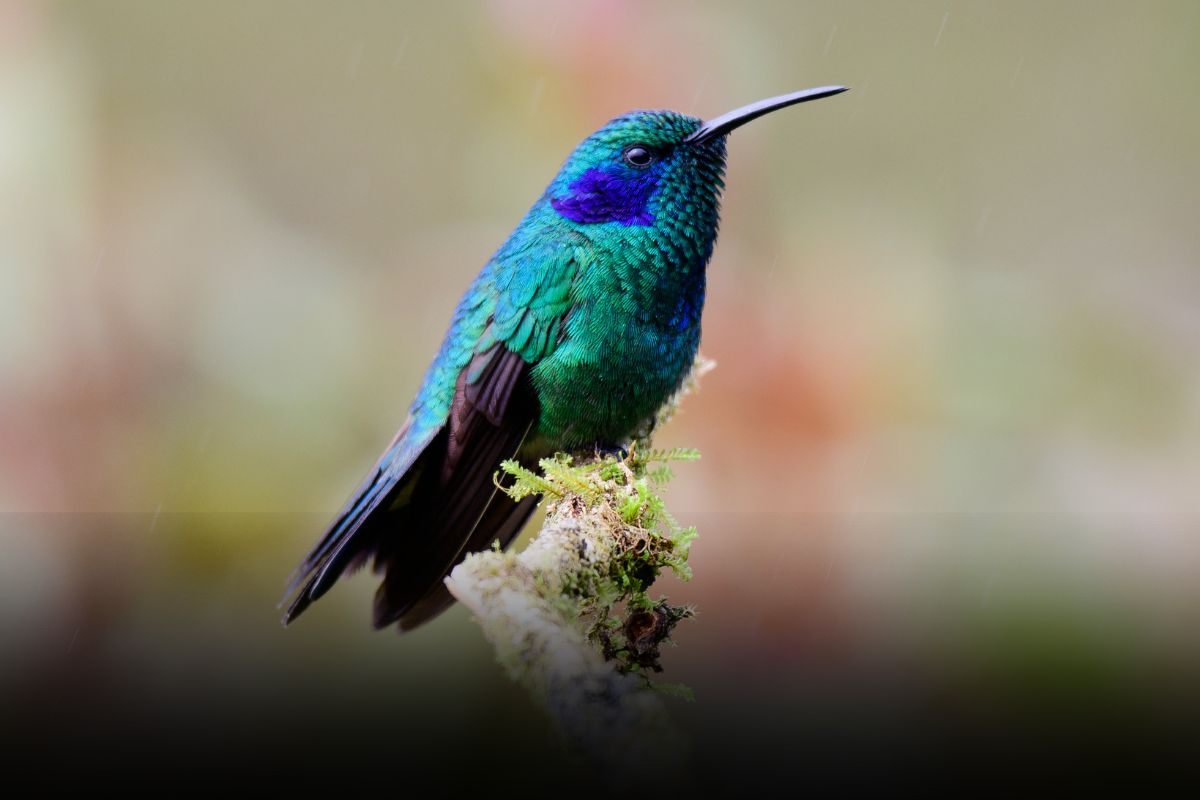
Where in Florida does it find?
The Green Violetear can be occasionally found in southern parts of Florida, particularly in tropical gardens and areas with flowering plants.
Short Description of the bird
The Green Violetear is a small hummingbird with iridescent green plumage, a black mask, and a long, slightly decurved bill. Males have a violet-blue spot near the ear.
Where to find this bird
Green Violetears are attracted to gardens with nectar-producing flowers and feeders. They are known for their hovering flight and the humming sound they create with their rapid wingbeats.
Size of the bird, wings, weight
Green Violetears are about 4-4.5 inches long with a wingspan of 6-7 inches. They weigh around 0.2-0.3 ounces.
Diet
Green Violetears primarily feed on nectar from flowers, using their long, specialized bill to reach within the blossoms. They also consume small insects as a source of protein.
How to identify
The Green Violetear is unmistakable with its vibrant green plumage, black mask, and long, decurved bill. The males have an additional violet-blue spot near the ear. Spotting them can be a challenge as they move quickly and prefer to hover and feed in the midst of flowering plants.
Green Jay
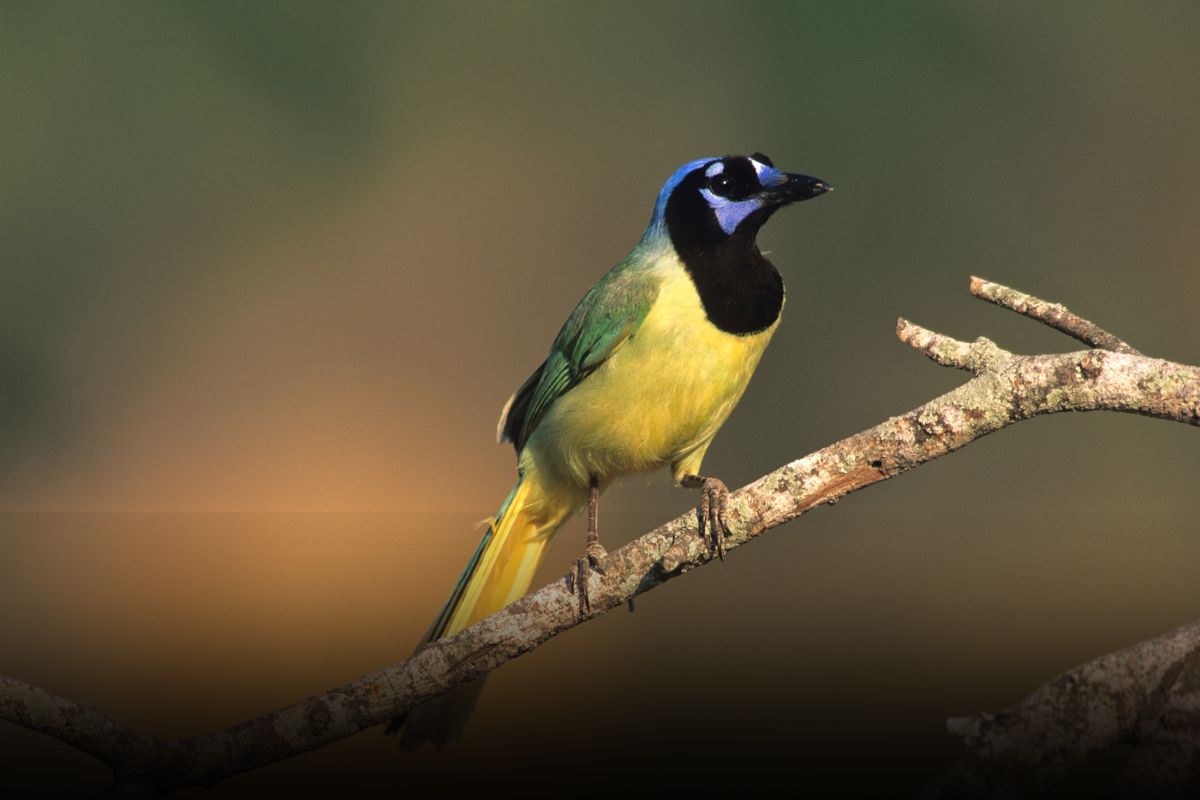
Where in Florida does it find?
The Green Jay can be found in the southernmost parts of Florida, particularly in dense forests, woodlands, and thorny scrub habitats.
Short Description of the bird
The Green Jay is a medium-sized bird with bright green plumage, a blue upper body, and a black mask. It has a long tail and a stout bill.
Where to find this bird
Green Jays are social birds often seen in small groups or family units. They are known for their distinctive vocalizations and can be found foraging for fruits, insects, and small vertebrates in trees and shrubs.
Size of the bird, wings, weight
Green Jays are about 11-12 inches long with a wingspan of 14-16 inches. They weigh around 2.5-3 ounces.
Diet
Green Jays have an omnivorous diet, feeding on fruits, insects, small vertebrates, and even eggs. They have a strong bill that allows them to crack open nuts and seeds.
How to identify
The Green Jay stands out with its bright green plumage, blue upper body, and black mask. It has a long tail and a stout bill. They are often heard before they are seen, as they make a variety of calls ranging from harsh screeches to melodic whistles.
Green Parakeet
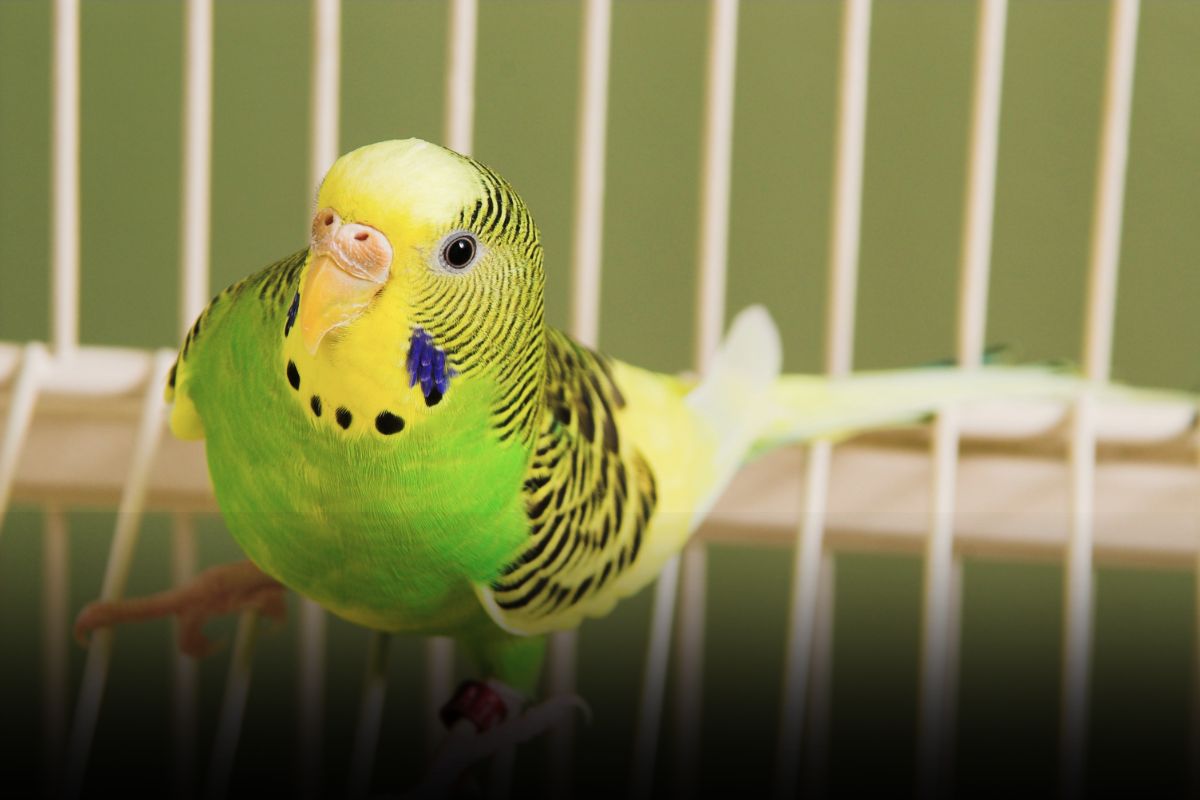
Where in Florida does it find?
The Green Parakeet can be found in the southern parts of Florida, particularly in urban areas, parks, and gardens with mature trees.
Short Description of the bird
The Green Parakeet is a small parrot with bright green plumage, a long tail, and a curved beak. It has a unique call that is often described as a loud, piercing scream.
Where to find this bird
Green Parakeets are highly social birds and are often seen in large flocks, perched on tree branches or exploring urban areas for food. They feed on fruits, nuts, seeds, and flowers.
Size of the bird, wings, weight
Green Parakeets are about 12-13 inches long with a wingspan of 18-20 inches. They weigh around 2.5-3.5 ounces.
Diet
Green Parakeets primarily feed on fruits, seeds, nuts, and flowers. They have a strong beak that allows them to crack open hard-shelled seeds and nuts.
How to identify
Identifying the Green Parakeet is easy with its bright green plumage, long tail, and curved beak. They are often seen in large, noisy flocks, with their distinctive calls filling the air.
Green Kingfisher
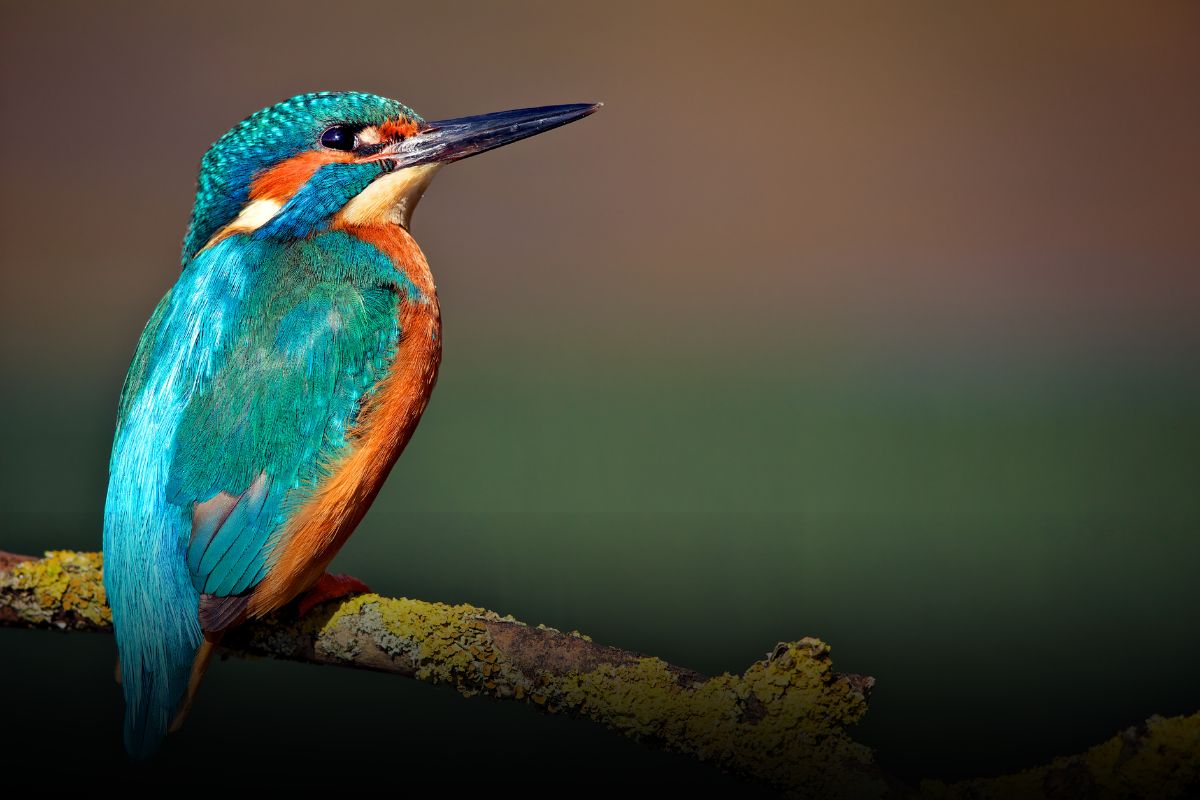
Where in Florida does it find?
The Green Kingfisher can be found in the southern parts of Florida, particularly near freshwater habitats such as rivers, lakes, and ponds.
Short Description of the bird
The Green Kingfisher is a small bird with greenish-brown plumage, a shaggy crest, and a long, straight bill. It has a short tail and short legs.
Where to find this bird
Green Kingfishers are skilled fishers and can often be seen perched on branches near the water’s edge, patiently waiting for fish and aquatic insects to swim by. They are known for their quick dives into the water to catch their prey.
Size of the bird, wings, weight
Green Kingfishers are about 7-8 inches long with a wingspan of 12-14 inches. They weigh around 1.2-1.5 ounces.
Diet
Green Kingfishers primarily feed on small fish, crustaceans, and aquatic insects. They can plunge into the water from perches or hover briefly before diving to catch their prey.
How to identify
The Green Kingfisher can be identified by its greenish-brown plumage, shaggy crest, and long, straight bill. It has a compact body and short tail. Look for them near water bodies, perched low to the ground, and watch for their impressive fishing skills.
Green-tailed Towhee
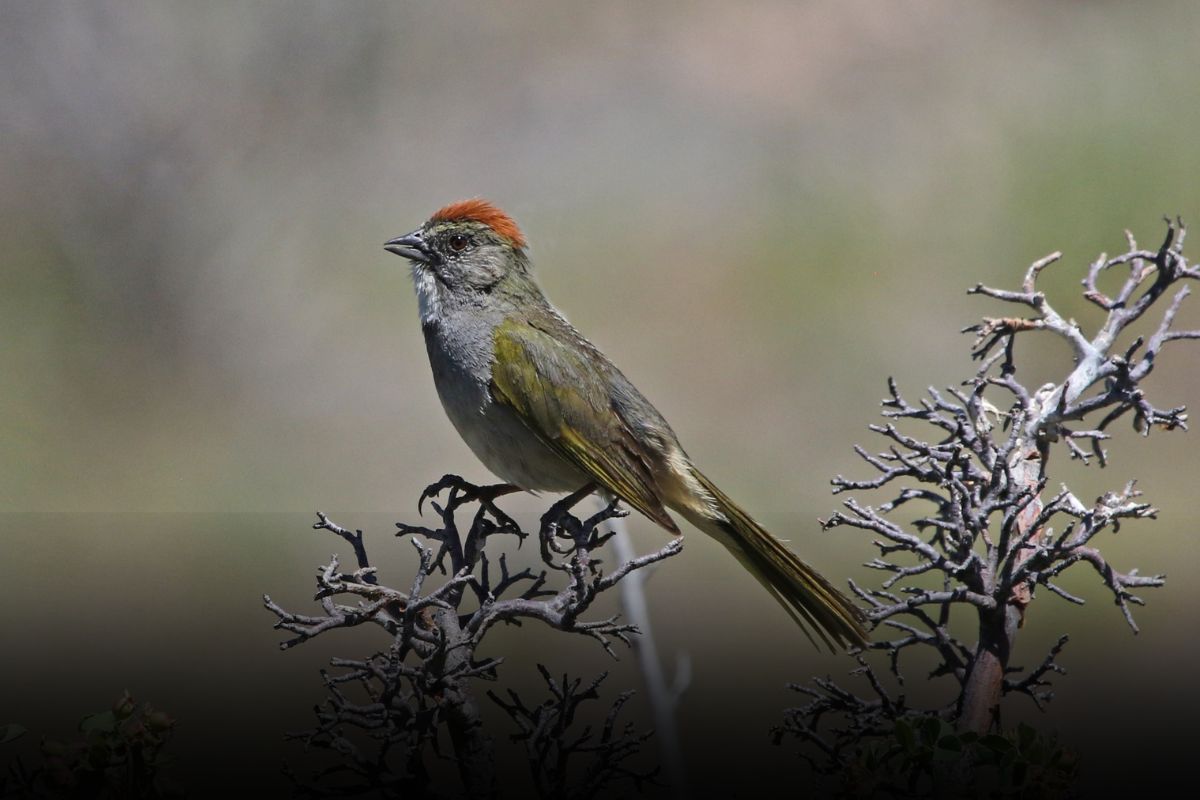
Where in Florida does it find?
The Green-tailed Towhee can be found in the northern and central parts of Florida, particularly in shrubby habitats, open woodlands, and brushy clearings.
Short Description of the bird
The Green-tailed Towhee is a small bird with a greenish back, reddish-brown wings, and a long, dark tail with green feathers. It has a rusty-colored cap.
Where to find this bird
Green-tailed Towhees prefer dense shrubs and low vegetation for foraging and nesting. They often stay close to the ground, scratching in the leaf litter for insects and seeds.
Size of the bird, wings, weight
Green-tailed Towhees are about 6-7 inches long with a wingspan of 8.5-9.5 inches. They weigh around 0.7-1 ounce.
Diet
Green-tailed Towhees have an omnivorous diet, feeding on seeds, fruits, insects, spiders, and small invertebrates. They use their stout bill to search for food on the ground and in vegetation.
How to identify
The Green-tailed Towhee is easily identified by its greenish back, reddish-brown wings, and long, dark tail with green feathers. It has a rusty-colored cap on its head. Watch for them near shrubby areas and listen for their distinctive trilling song.
Exploring the diverse species of small green birds in Florida opens up a world of vibrant colors, unique behaviors, and captivating sights. Keep your eyes and ears open as you venture into nature, and enjoy the beauty of these feathered wonders.
Nanday Parakeet
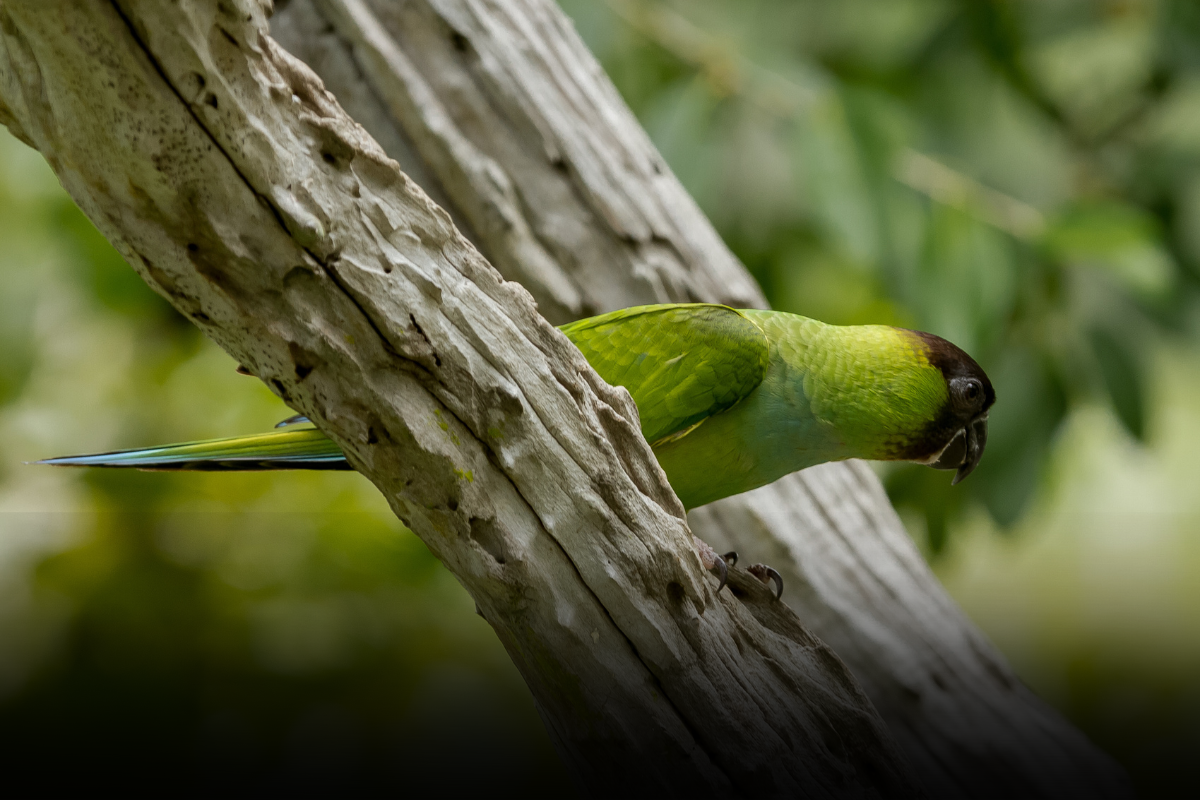
Where in Florida does it find?
The Nanday Parakeet can be found in several parts of Florida, particularly in urban areas, parks, and neighborhoods with mature trees.
Short Description of the bird
The Nanday Parakeet is a small parrot with dark green plumage, a black head, and a blue rump. It has a distinctive loud, screeching call.
Where to find this bird
Nanday Parakeets are highly social birds often seen in large flocks, perched on tree branches or flying overhead. They feed on fruits, seeds, nuts, and occasionally insects.
Size of the bird, wings, weight
Nanday Parakeets are about 12-14 inches long with a wingspan of 24-26 inches. They weigh around 4-5 ounces.
Diet
Nanday Parakeets primarily feed on fruits, seeds, nuts, and occasionally insects. They have a strong beak that allows them to crack open hard-shelled seeds.
How to identify
The Nanday Parakeet can be identified by its dark green plumage, black head, and blue rump. They fly in large flocks, creating a cacophony of screeching calls as they move. Look for them in urban areas and listen for their distinct vocalizations.
Pine Warbler
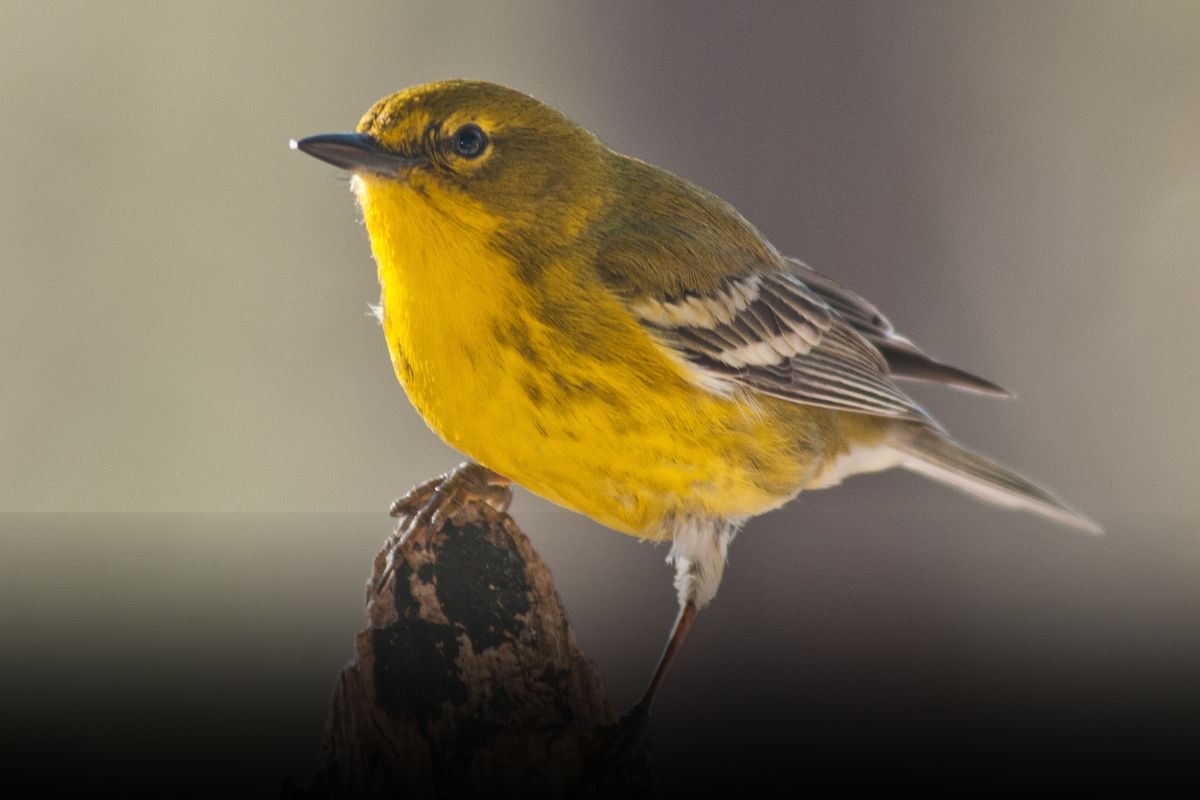
Where in Florida does it find?
The Pine Warbler can be found throughout Florida, particularly in pine forests, mixed woodlands, and areas with tall coniferous trees.
Short Description of the bird
The Pine Warbler is a small songbird with olive-green plumage, yellow underparts, and a striped face. It has a slender bill.
Where to find this bird
Pine Warblers are known for their affinity for pine trees and are often seen foraging among the branches and needles. They primarily feed on insects, spiders, and occasionally seeds.
Size of the bird, wings, weight
Pine Warblers are about 5-6 inches long with a wingspan of 9-10 inches. They weigh around 0.4-0.5 ounces.
Diet
Pine Warblers primarily feed on insects, spiders, and occasionally seeds. They use their slender bill to extract insects from pine needles and branches.
How to identify
The Pine Warbler can be identified by its olive-green plumage, yellow underparts, and striped face. Look for them in pine forests and listen for their song, which is a series of musical trills and warbles.
Hooded Warbler
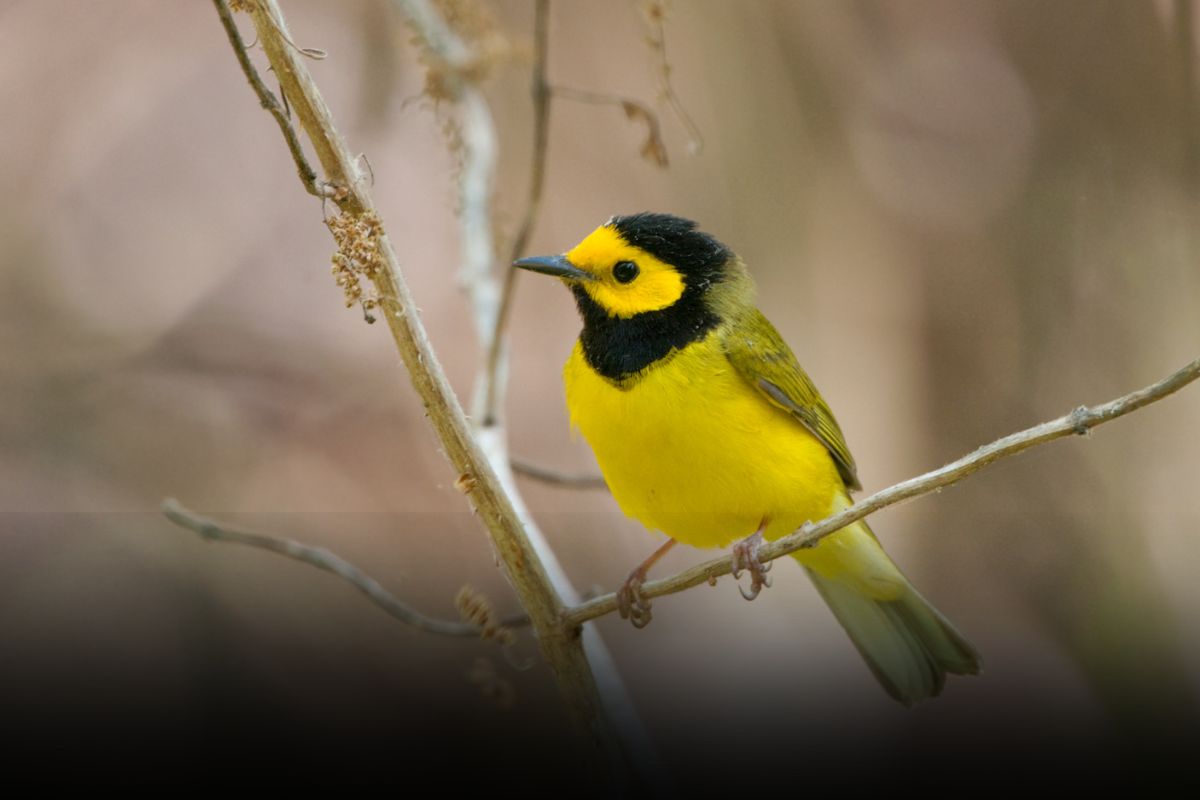
Where in Florida does it find?
The Hooded Warbler can be found in various parts of Florida, particularly in swampy areas, wetlands, and thickets near water sources.
Short Description of the bird
The Hooded Warbler is a small songbird with a black hood, yellow face and underparts, and olive-green upperparts. It has a slender, pointed bill.
Where to find this bird
Hooded Warblers prefer low, dense vegetation near water sources. They forage on or near the ground, hunting for insects, spiders, and small invertebrates.
Size of the bird, wings, weight
Hooded Warblers are about 4.5-5 inches long with a wingspan of 7.5-8 inches. They weigh around 0.3-0.4 ounces.
Diet
Hooded Warblers primarily feed on insects, spiders, and small invertebrates. They search for food by hopping along the ground or foliage, occasionally hovering to catch flying insects.
How to identify
The Hooded Warbler can be identified by its black hood, yellow face and underparts, and olive-green upperparts. Look for them in wetland areas and listen to their distinctive song, which is a series of clear, ringing notes.
Ruby-crowned Kinglet
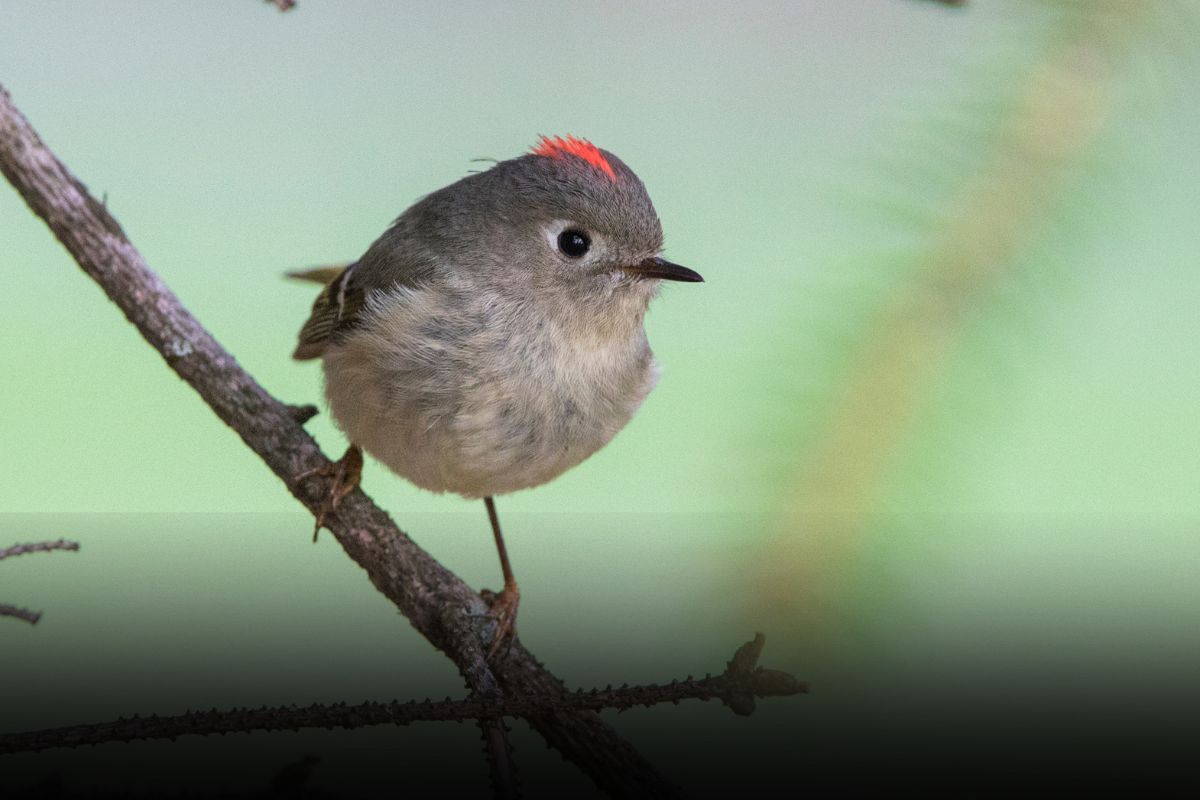
Where in Florida does it find?
The Ruby-crowned Kinglet can be found throughout Florida, particularly in forests, woodlands, and areas with dense vegetation.
Short Description of the bird
The Ruby-crowned Kinglet is a small bird with olive-green plumage, a white eye-ring, and a ruby-red crest on top of its head. It has a slender bill.
Where to find this bird
Ruby-crowned Kinglets are highly active birds that move rapidly through dense vegetation, often in the lower and middle levels of trees. They primarily feed on insects and spiders.
Size of the bird, wings, weight
Ruby-crowned Kinglets are about 4-4.5 inches long with a wingspan of 7.5-8 inches. They weigh around 0.2-0.3 ounces.
Diet
Ruby-crowned Kinglets primarily feed on insects, spiders, and occasionally small fruits. They forage by hovering, flitting, and gleaning insects from leaves and branches.
How to identify
The Ruby-crowned Kinglet can be identified by its olive-green plumage, white eye-ring, and small size. The ruby-red crest on top of its head is often hidden but can be visible when the bird is excited or displaying. Look for their quick, darting movements in forested areas and listen for their high-pitched calls.
Ovenbird
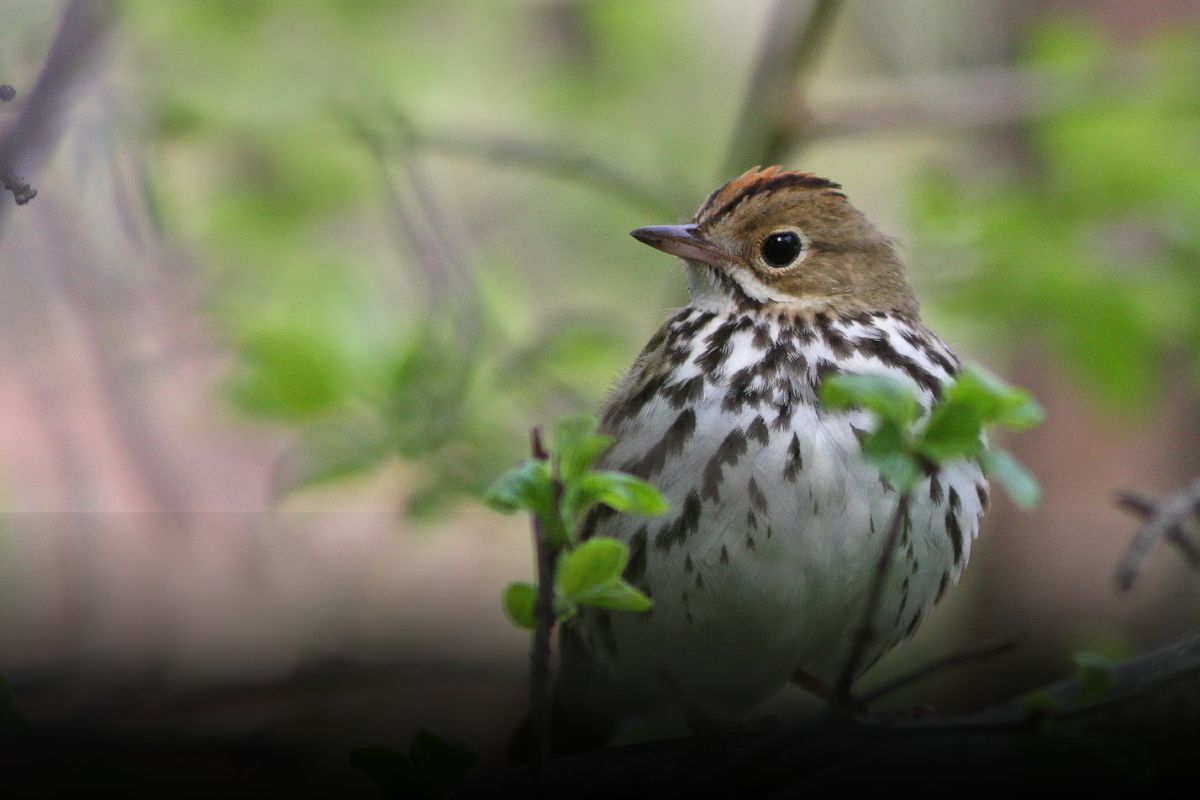
Where in Florida does it find?
The Ovenbird can be found in various parts of Florida, particularly in forests, woodlands, and areas with dense undergrowth.
Short Description of the bird
The Ovenbird is a small songbird with brown upperparts, a white belly with dark streaks, and a distinctive orange crown with dark stripes. It has a stout bill.
Where to find this bird
Ovenbirds are ground-dwelling birds that prefer areas with leaf litter or dense undergrowth. They forage by scratching through the forest floor and feeding on insects, spiders, and other invertebrates.
Size of the bird, wings, weight
Ovenbirds are about 5-6 inches long with a wingspan of 7.5-8 inches. They weigh around 0.7-0.9 ounces.
Diet
Ovenbirds primarily feed on insects, spiders, and small invertebrates found on the ground or among leaf litter. They use their stout bill to probe and pick prey.
How to identify
The Ovenbird can be identified by its brown plumage, white belly with dark streaks, and distinctive orange crown with dark stripes. Look for them on the forest floor, and listen for their loud, ringing song that sounds like “teacher, teacher, teacher” repeating rapidly.
Exploring the world of small green birds in Florida brings a sense of wonder and appreciation for the diverse birdlife that inhabits this beautiful state.
From the vibrant parakeets to the elusive warblers, each bird offers its own unique beauty and charm. So grab your binoculars, explore the natural habitats, and enjoy the delightful sights and sounds of these small green avian wonders.

